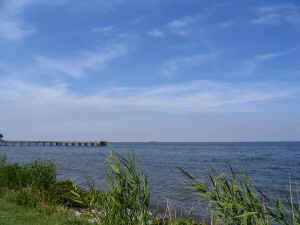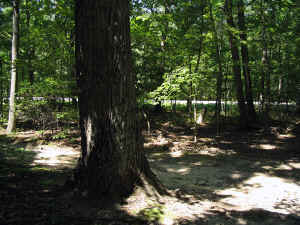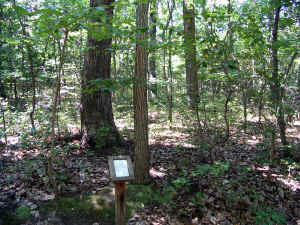Greetings, fellow ENTS!
On the first weekend of August I was suffering from "summer
fever" -
it's similar to spring fever (when one wants to get outside
after a long
winter), but it is caused by a desire to get outside and enjoy
the
outdoors after too many days of "hazy, hot, and humid"
weather
(including a few days with temperatures reaching or exceeding
100
degrees F.)

A view northward up the Bay from the grassy beach at John Downs
Memorial Park.
Well, my normal woodland haunt (Patapsco State Park) was overrun
with
coworkers that weekend because of a department picnic, so I had
to find
another place to which I could escape from civilization.
Some online digging around led me to the Anne Arundel County
list of
county parks. Now, many county parks are just areas in which
people can
play sports (which is fine if you are interested in that) and
are thus
crowded and lacking in trees, but some of the ones listed
actually had a
focus on nature. So, I set my sights on John Downs Memorial Park
(commonly shortened to "Downs Park") at the end of
Mountain Road, right
by the Chesapeake Bay. This park is about 245-acres in size and
contains
a mix of forests, some open beaches and picnic areas, a nature
center/garden, and a great view of the Bay.
The trip was definitely worth my time, and this little hidden
gem of a
park is now on my list of neat, local places to visit!
Anyway, here's a more detailed look at what I saw there.
Downs Park is much smaller than Patapsco (although one doesn't
really
see all of Patapsco, or even most of it, in a normal trip), and
its
forest generally seems to be younger. However, there are still a
respectable number of large, old trees in the park, and that
number will
continue to increase since most of this park is wooded. The
woods are
large enough to surround you, silence the outside world, and
allow a
connection to nature. While this is not a scientific
"measurement" of
the size of a forest, it is still very important. The sense of
wilderness and isolation is key to instilling the importance of
the
woods in others, as well as being vital for people like us Ents
who need
to connect to nature, trees in particular.
Here's some more detailed, species by species information
regarding what
I found in the park. The soil in the park was generally sandy
and the
terrain was flat. I am not sure of the drainage, but a look at
the
species list seems to indicate that it may be better than one
would
think for a place right next to the Bay.

An good view of the forest - a mix of young trees and some quite
large, older trees - taken at the base of what I believe is a large white
oak tree. There was another, larger white oak nearby, but it sadly has
suffered serious crown damage and may not live much longer.
- White Oaks: Many of the larger trees in the forest were common
white
oaks, and they reached respectable sizes. I'd say 3-feet in
diameter was
not uncommon, and I think there were some 4-foot or more
diameter beasts
here and there. Heightwise, I am not sure, but the trees here
were not
as tall as those in Patapsco - perhaps because of age, perhaps
because
of their proximity to the Bay (and thus winds from storms.)

This big tree is a fine example of the chestnut oaks that live in
this park. While reasonably tall, the sheer mass of the tree is what first
catches one's eye. Many of the chestnut oaks in the park are big,
low-branching trees, which may have saved them from the saw years ago.
- Chestnut Oak: This was a new species to me - yeah! I've read
about
them, and they live up to their reputation of being big, gnarly
trees
with very thick and deeply fissured bark. They also seem to
branch low -
I am not sure if that is a result of the growing conditions, or
perhaps
the trees that branched low were considered poor timber trees
and were
thus allowed to keep growing (like most parks, this one was
privately
owned land at one time). I thought I read somewhere that
chestnut oaks
were considered poor lumber trees, and I think low-branching
might have
been why... Hmmm... Anyway, these trees were at least as large
as the
white oaks, and were even more imposing because of the low
branches. I
am not sure of the sizes, but 4-foot+ diameter was a certainty
for some
of the bigger brutes, although low branching is
"cheating" when it comes
to large trunk sizes - just don't tell that the chestnut oaks!
You know what the problem is with encountering new species?
Doing so
continues to increase the number and variety of trees that I'd
like to
have on my property someday... If only Maryland's housing prices
were
not so high! Oh, that's another brief detour: on the way down
there, I
saw so many signs to new developments it was insane! Sadly, most
of the
homes were huge, "McMansions" with tiny yards and
barely room for a
weed-tree, much less something like a chestnut oak. Sigh.
- Sweetgums: Interestingly, sweetgums made up a good deal of the
forest
at Downs Park. I've never really considered the common sweetgum
as a
large tree or much more than a producer of annoying, spiked
seedballs,
but they reached good sizes in this park. Not as big as the
oaks, but
certainly large and mature - probably 3-feet in diameter or so.
They
also are pretty bold trees. Once I left the wooded area, I found
perhaps
the largest ones growing in isolated or semi-isolated clumps
right down
near the water! Apparently, they are able to take the winds of
storms
that come up the Bay.
- Sassafras: This modest tree was very common in the understory
of the
forest - its distinctive leaves gave it away. Not a big tree by
any
standard, but a nice, little one with good fall color.
- Hickories and Pecans: I am lousy at ID'ing the various
varieties of
hickories, and it is often tricky to find the tree itself. I'll
find the
nuts on the forest floor (old ones from last fall this time of
year),
but it can be a challenge to find the actual tree. They tend not
to
branch low and they don't put on a lot of trunk girth, either,
so they
do an amazingly good job blending in. I found the nuts from at
least one
variety of hickory, and I also found the elongated, hickory-like
nut of
what I think would be a pecan, so they are out there. That seems
to be
the story of all the hickories - they are "out there"
in the forest, but
rarely found in large groves, much less pure stands.

This is the American chestnut tree that I found in the park. The
plaque in the center of the photo points out this small tree, and the tree
itself is the small, straight one to the right and behind the plaque. The
big, looming tree in the background is a dead member of some other species
and thus will no longer be shading out this chestnut tree.
- American Chestnut: The find of the day! As I was walking along
one of
the trails, I finished looking at the tree seedlings and turned
to
continue heading up the path when I saw a sign detailing the
chestnut
blight. I was surprised by this, and then I started to wonder
"could
there be a chestnut here?" - another sign nearby then
pointed out a
modest, surviving American chestnut tree - I could hardly
contain my
excitement. After looking over the leaves and bark to make sure
it was
an American chestnut, I contemplated my good fortune. I've only
read
about them and never seen one in person, much less in the wild.
The tree
is about 6" in diameter (estimate) and about 20 to 30 feet
tall - it is
bending around a now-dead tree of some other species that was
previously
shading it out. It is old enough to have the distinctive grooved
and
plated mature American chestnut bark a good way up the length of
the
tree (10+ feet). There is no obvious sign of the blight on the
tree that
I could tell - no open wounds, cankers, ooze, orange fungus,
etc.
There's also no sign of any burs in the leaf litter below the
tree, so
it may not yet be mature, or maybe there are no other mature
American
chestnuts nearby.
The information this tree was sent off to the American Chestnut
Foundation so they can add it to their database. It was an
amazing find
- I know that regenerating American chestnuts are not as
uncommon as one
might think, and there's no reason to believe this tree has any
resistance to the blight, but still... one can hope, and it was
great to
find one of these trees at last.
- Conifers: Sorry, but I am lousy with conifer ID, but there
seemed to
be a somewhat higher concentration of conifers at Downs Park
than at
Patapsco, but they were still a relatively minor part of the
forest.
Oddly, the greatest number of them were found down near the Bay,
but
those might have been planted by people. Most of the ones in the
woods
appeared to be pines of some sort, but like I said, I am not
good at
ID'ing them and most of their needles were way up near the top
of the
canopy.
One interesting part of this is how different the forest is from
what I
found at Patapsco State Park. Patapsco, at least the southern
area, is
dominated by tulip poplars in all areas, sycamores along the
river and
in lower areas, and American beech trees in the understory and
in the
rockier, higher elevations. I saw very few tulip poplars at
Downs Park,
not a single sycamore, and one, sickly American beech tree near
the
water that looked rather out of place. On the other hand,
Patapsco has a
lower concentration of sweetgums and sassafras, and I can't say
that
I've ever seen a chestnut oak there. I am sure Patapsco has a
wider
variety of trees since it is considerably larger and older as a
park,
but Downs park has a rather unusual mix in its own right.
Interestingly,
I suspect Downs Park is also a great place to go for fall color:
sweetgum and sassafras have very nice fall colors, and even
chestnut
oaks are supposed to look good in the fall.
So, that's a summary of the relatively hidden forest at John
Downs
Memorial Park in Maryland. After leaving the woods, I walked
down along
the grassy beach along the Bay, and the view was wonderful! I
could look
out across the water and just make out the opposite shore, and
the
breeze from the Bay kept the temperature pleasant even though it
was a
warm day. Good-sized trees lurk near the water in a few places,
while
most of the area is a grassy beach with benches on which one can
sit to
enjoy the view. Concerts of various sorts are held at this park
during
summer months on weekends, and there is an ice-cream vendor in
the park,
too, which was nice on a warm day. While this park is on the
small size
and does not have the fame of a state park, like Patapsco, it is
a nice
place to visit - with a forest large enough to enjoy and a view
of the
Bay that is well worth the drive.
Enjoy!
|